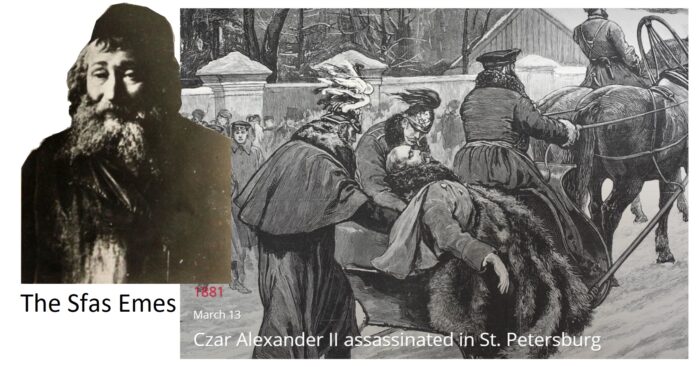
At times, one needs to understand the historical context of what our Gedolim have said – in order to fully plummet their meaning. This is especially true regarding the Sfas Emes, who lived during very dark times. In his piece on Parshas Vayigash (1884), this author believes we can gain new depth and inspiration through an examination of the circumstances behind his remarkable thought.
In recent times, many people have expressed shock at the rate of the societal decline around us. The Gerrer Rebbe, Rabbi Yehudah Aryeh Leib Alter (1847-1906), author of the Sfas Emes (Parshas Vayigash 5644 – 1884) lived and led his Chassidus during a very difficult time in Jewish history during our sojourm in Tsarist Russia. Let us get a brief picture of what going on. The Jewish nation had endured some horrible years under Nicolai the First. He had tried to convert young Jewish children by forcibly placing them in the army. These were called, “The Cantonist Decrees.” Young Jewish children were kidnapped by Khappers and placed in the Tsar’s army under dire circumstances. Klal Yisroel suffered immensely.
Then, it seems, that there was a bit of a reprieve. The next Tsar – Alexander the Second was much more liberal. He undid the Cantonist Decrees of his father. The harsh regime and rule of Tsarist Russia, seemed to have a bright light. But, he was soon assassinated. The next Tsar, Alexander the Third was a despot. Horrific pogroms soon ensued and the new Tsar was no friend of the Jews. Au contraire, he unleashed a notorious era of cruelty and anti-semitism.
In Parshas Vayigash of 1884, the Sfas Emes spoke. He explained one of the psukim in our parsha (Bereishis 46:4) which states, “And I shall go down with you toward Egypt” in the following manner:
This is actually a promise that Hashem will fulfill not just then to Yaakov Avinu, but for all future times – even our own times. It is connected to the pasuk in Tehillim (91:15), “And I shall be with him in sorrow.” This is what is elaborated in the Gemorah (Megillah 29a): “When they were exiled to Mitzrayim and to Bavel, the Shechina was with them.”
The meaning is that, somehow, someway, through the midos and character traits of Yaakov Avinu, the Shechina will dwell among Israel, even in the exile. This is the meaning of “Ered imcha Mitzraima – I shall go down with you toward Mitzrayim.”
The emphasis is that it is specifically with you and because of you. Hashem is telling Yaakov Avinu that he, Yaakov Avinu, is the reason. Through Yaakov, the Shechina will remain with us in the exile.
And, the Sfas Emes explained that it did transpire in the following manner: Through the shvatim, Yoseph went down to Mitzrayim. Through Yoseph, Yaakov Avinu went down to Mitzrayim. And through Yaakov Avinu, the Shechina went down to Mitzrayim.
It is quite clear that there is a sub-text going on here in the words of the Holy Sfas Emes. Through the shvatim – through the sins of the rest of the nation of Israel, the shvatim– meaning the Jews, we went down to this galus of a galus– that of Tsarist Russia beginning during the period of Tsarina Catherina when she took over Poland in 1795. But through Yoseph, i.e. the tzaddikim in Klal Yisroel, the unique Midah of Yaakov Avinu – meaning Emes – acting with truth at all times, the Shechina itself will be with us in this dark galus of a galus once again.
The Sfas Emes goes on to reassure us. Do not make an error to think that this level is far beyond us.
The fact is that within the nation of Israel, the essence and root of Yaakov Avinu is constantly with us, as Chazal have said, “the face of Yaakov Avinu is etched onto the Kisei HaKavod, therefore, any place that he (Yaakov Avinu) went down to, the Shechina went with him as well. The Sfas Emes explains this Midrash as follows: The metaphorical meaning of the face of Yaakov Avinu being etched onto the Kisei HaKavod is that the Shechina will always be with us when we exhibit the trait bequeathed to us by Yaakov Avinu. This is through the trait of Emes – truth, as it states in Micha (7:20), “You shall give the truth of Yaacov, the loving-kindness of Avraham, which You swore to our forefathers from days of yore” – which refers to the signet ring of Hashem.
“Therefore,” continues the Gerrer Rebbe, “through the trait of Emes – we can receive a chiyus – in other words – a life-sustaining injection in the exile as well.
“For the eclipsing and overshadowing of redemption is through sheker – lies.” It is clear that the Sfas Emes is referring to why the temporary reprieve of Alexander the Second’s reign was so short. He is explaining that it is due to our own spiritual decline. Things don’t just happen because a revolutionary band called the “People’s Will” throw a bomb in St. Petersburg at the Tsar of Russia! “For the fact is,” continues the Sfas Emes, “that Hashem’s dominion exists no matter what the government or temporal authority may be. Therefore, through the character trait of truth, redemption is awoken.”
When we realize the events that had transpired immediately before and during this remarkable section of the Sfas Emes, we now further understand that the Gerrer Rebbe is thus providing us with an avenue as to where we can direct our avodas Hashem. He is telling is that in order to face the societal downfalls that we are experiencing – we can and must make the commitment to everyday emes.
As reported by VINnews
